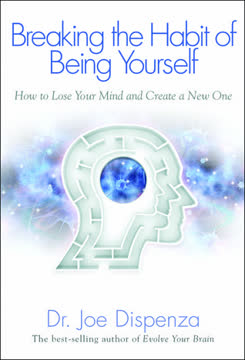Key Takeaways
1. Quantum Mechanics Explains Life's Fundamental Paradoxes
"Everything seems bright again," "The clouds are gone," "There is light at the end of the tunnel," "Every cloud has a silver lining," "If it is winter, can spring be afar?"
Quantum insights illuminate life. The quantum world, with its counterintuitive principles, offers surprising parallels to human experiences. Concepts like superposition, wave-particle duality, and quantum tunneling provide metaphors for understanding life's paradoxes. For instance, Schrödinger's cat thought experiment, where a cat is simultaneously alive and dead until observed, mirrors how our existence is validated through social interactions.
Quantum parallels in life:
- Superposition: Multiple possibilities exist until a decision is made
- Wave-particle duality: People exhibit different aspects in various situations
- Quantum tunneling: Overcoming seemingly insurmountable obstacles
These quantum concepts offer a fresh perspective on human behavior, relationships, and the nature of reality itself, encouraging us to embrace life's inherent uncertainties and contradictions.
2. The Universe and Human Nature Share a Tendency Towards Laziness
"Ah, what a justification for laziness! We humans are lazy by nature, and it turns out that so is nature."
The principle of least action governs both the universe and human behavior. In physics, this principle states that objects naturally follow the path of least resistance. Similarly, humans often seek the easiest route to achieve their goals. This inherent laziness is not necessarily negative; it drives innovation and efficiency.
Examples of least action in nature and human behavior:
- Light traveling the quickest path between two points
- Water flowing downhill along the path of least resistance
- People creating shortcuts to save time and energy
- Technological innovations aimed at reducing effort
Understanding this principle can help us harness our natural tendencies for productivity and recognize when additional effort is necessary to overcome our inherent laziness.
3. Fluctuations and Dissipation Define Our Struggles and Successes
"Fluctuations are an inherent part of the reality of this universe; fluctuations fundamentally differentiate the ideal from the real, in both nature and in life."
Life's ups and downs mirror the fluctuation-dissipation theorem in physics. This principle states that the energy lost in a system is directly related to the fluctuations within it. In human terms, our struggles (fluctuations) often lead to energy loss (dissipation), but they also drive progress and growth.
Applications of fluctuation-dissipation in life:
- Overcoming obstacles leads to personal growth
- Relationship conflicts can strengthen bonds when resolved
- Economic boom-bust cycles drive innovation and adaptation
- Stress and recovery in physical exercise improve fitness
Embracing fluctuations as a natural part of life can help us build resilience and appreciate the value of both struggles and successes in our personal development.
4. Relationships Are Governed by Wave Mechanics and Interference
"Relationships are perhaps the most confounding of life experiences. Practice seems to make less perfect, and endless analysis distills more confusion!"
Relationship dynamics can be understood through the lens of wave mechanics. Just as waves can interfere constructively or destructively, people's personalities and behaviors can either amplify or cancel each other out in relationships. This analogy helps explain why some partnerships thrive while others struggle.
Wave mechanics in relationships:
- Constructive interference: Compatible traits strengthen the bond
- Destructive interference: Conflicting personalities create tension
- Resonance: Shared interests and values amplify connection
- Phase differences: Misaligned goals or communication styles cause discord
By viewing relationships through this quantum perspective, we can better understand compatibility, communication challenges, and the importance of aligning our "wavelengths" with others for harmonious interactions.
5. Time is Relative in Both Physics and Human Experience
"Time for me is definitely going a lot faster these days than it used to when I was a teenager!"
The perception of time is subjective and varies based on our experiences, mirroring Einstein's theory of relativity. Just as time dilates for objects moving at high speeds, our perception of time changes throughout our lives and in different situations.
Factors influencing time perception:
- Age: Time seems to pass more quickly as we grow older
- Novelty: New experiences make time feel slower
- Emotion: Positive emotions can make time fly, while negative ones make it drag
- Focus: Engaging activities can make us lose track of time
Understanding the relative nature of time can help us make the most of our experiences, savor meaningful moments, and appreciate the subjective nature of our temporal perceptions.
6. Our Worldlines Shape Our Optimism and Life Trajectories
"Hope and optimism really are very much about having choices."
Life paths, or worldlines, determine our opportunities and outlook. In physics, a worldline represents an object's path through space-time. Similarly, our life trajectories are shaped by the choices we make and the opportunities available to us. The number and quality of potential worldlines influence our level of optimism.
Factors influencing our worldlines:
- Education and skills acquired
- Social connections and networks
- Economic circumstances
- Cultural and societal norms
- Personal decisions and risk-taking
Recognizing the multitude of potential worldlines can inspire us to make choices that open up more desirable paths and maintain a positive outlook on life's possibilities.
7. Surface Information Holds the Key to Understanding Complex Systems
"Beauty is only skin deep" is a rather scornful statement with a core of bitterness, uttered usually by people who do not feel so beautiful and, more often, by ones dumped and rejected by beautiful people.
Surface features reveal more than we often assume. In physics, principles like Gauss's law demonstrate that surface information can provide crucial insights about the interior of a system. Similarly, in human interactions, surface-level cues often contain valuable information about a person's character, intentions, and internal state.
Types of surface information in human interactions:
- Body language and facial expressions
- Tone of voice and speech patterns
- Clothing and personal presentation
- Social media presence and digital footprint
While it's important not to judge solely on appearances, recognizing the value of surface information can enhance our ability to navigate social situations and understand complex systems more effectively.
8. The Exclusion Principle Manifests in Human Behavior and Preferences
"We cherish our privacy, and we highly value our personal space, and we can be very protective of both."
Human desire for individuality mirrors the quantum exclusion principle. In physics, this principle states that no two identical fermions (a type of subatomic particle) can occupy the same quantum state simultaneously. Similarly, humans often seek to differentiate themselves and maintain personal space.
Manifestations of the exclusion principle in human behavior:
- Desire for privacy and personal space
- Pursuit of unique identities and self-expression
- Competitive behavior in social and professional settings
- Cultural emphasis on individuality in some societies
Understanding this principle can help us respect others' boundaries, appreciate diversity, and find a balance between individuality and social connection.
9. The Middle Path Offers Stability in Life, Mirroring Quantum Principles
"Everything that brings us joy and pleasure can also bring us sorrow and pain."
Balance and moderation are key to a stable life, reflecting quantum principles of equilibrium. In physics, the path integral approach suggests that the most probable path of a particle is often the average of all possible paths. Similarly, in life, following a middle path between extremes often leads to greater stability and satisfaction.
Benefits of the middle path:
- Reduced emotional volatility
- Increased resilience to life's ups and downs
- Better long-term decision-making
- Improved relationships through balanced perspectives
By embracing the middle path, we can navigate life's challenges more effectively, finding stability amidst the inevitable fluctuations of joy and sorrow.
Last updated:
Review Summary
The Quantum Rules receives mixed reviews, with an average rating of 3.63/5. Readers appreciate the author's ability to explain complex physics concepts in an accessible way, relating them to everyday life. Some find the analogies insightful and entertaining, while others consider them stretched or corny. The book is praised for its humor and unique perspective on physics and life. Critics note that some explanations feel oversimplified or hard to grasp. Overall, it's seen as an engaging introduction to quantum physics for non-scientists, though opinions vary on its effectiveness as a self-help guide.
Similar Books







Download PDF
Download EPUB
.epub digital book format is ideal for reading ebooks on phones, tablets, and e-readers.




